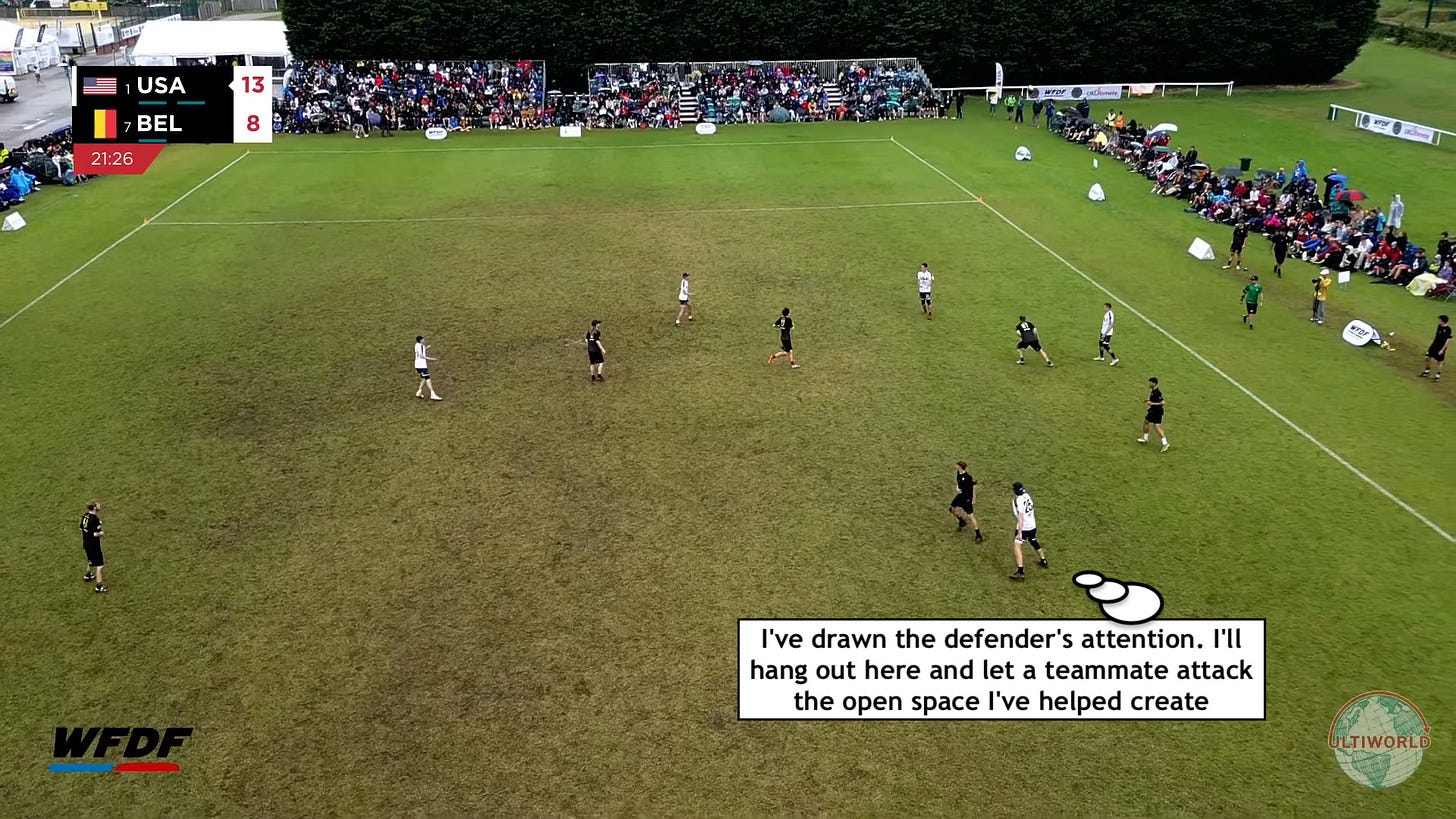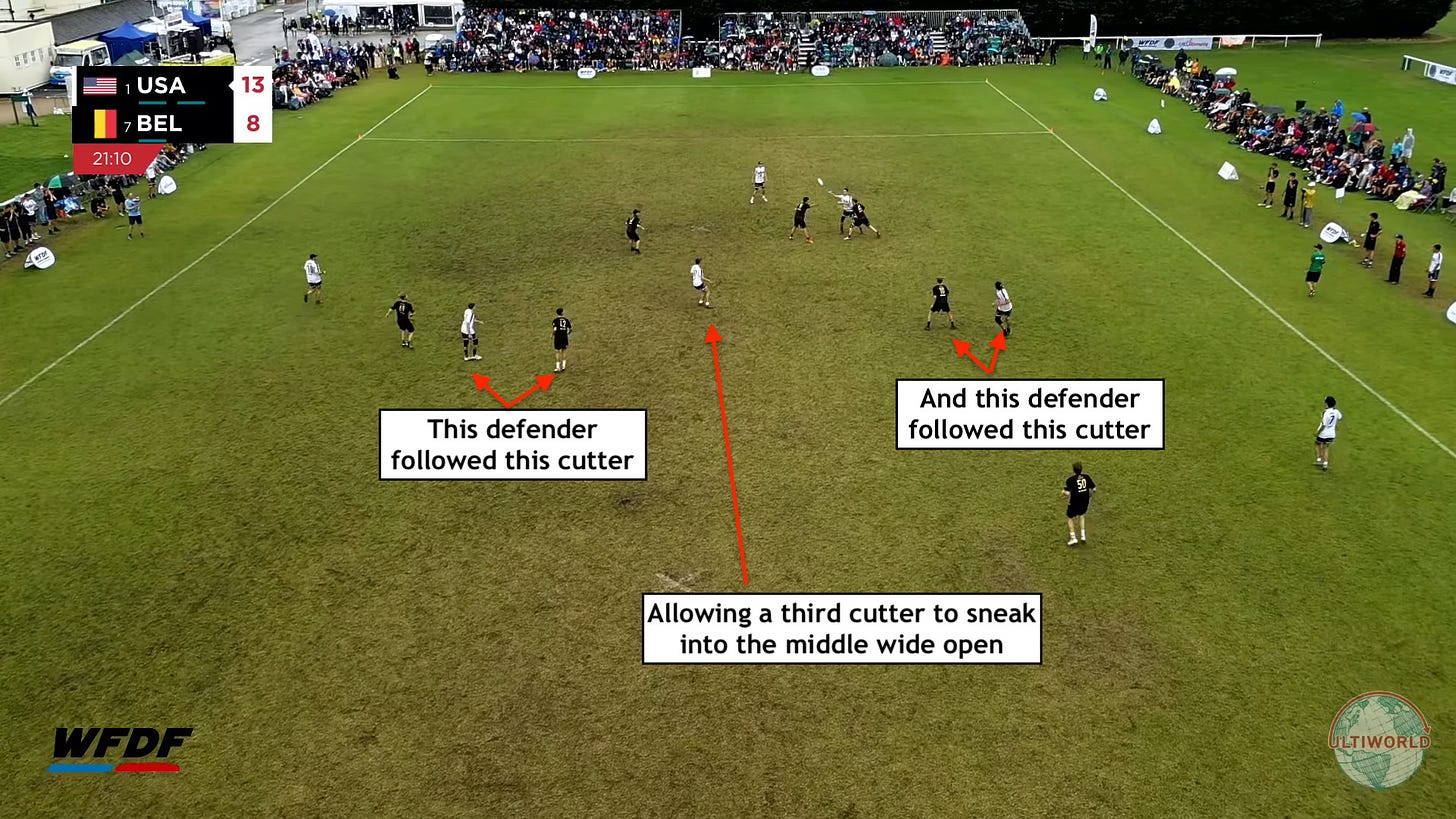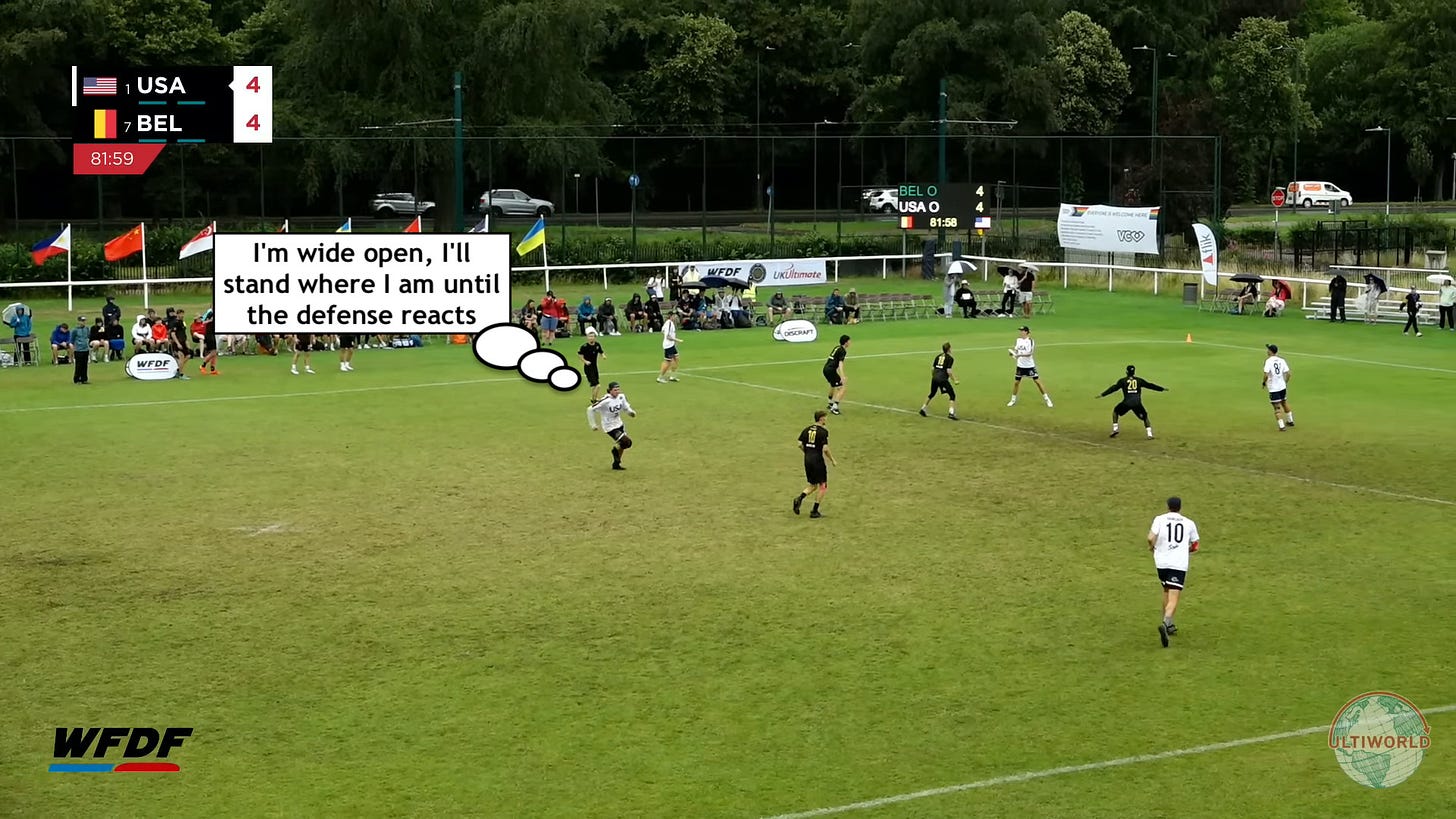[I've been working on an article titled "How do you actually beat a zone defense?" The article, and one section in particular, started to feel like it was getting too long. So here's that one section as a separate post.]
A number of the strategies used to beat a zone defense depend on offensive receivers getting open downfield. And though people often like to talk about "poppers", I'm of the opinion that's the wrong way to think about the downfield positions in a zone offense. Endlessly 'popping' in and out is not the way to go about getting open downfield. So what should downfield players do against a zone?
My main mental model is that of "running the option", a phrase that comes from American football. "The option" is a play where the offense isolates one defender and forces them to guard two players. When the defender commits to one player, the offense gives the ball to the other player.
Here's a clip from YouTube:
In the video above, #11 in white is left unblocked by the offense, but he has two players to guard. When he commits to stopping green's #12 (the quarterback), #12 pitches the ball to an unguarded #7, who's able to make quick forward progress.
The same concept works great against zone defenses in frisbee: two offensive players without the disc work together to give one zone defender more duties than they can handle.
If you're more of a board gamer than a football fan, a similar concept is the "overload", a term that comes from chess. A chess piece is overloaded (also called overworked) if it has more than one responsibility, and committing to one responsibility puts it in a spot where it can no longer fulfill its other role.

In the image above, the black pawn is defending both the knight and bishop. But imagine white's bishop takes black's knight and the black pawn recaptures. The black bishop is now undefended (since the pawn moved and is no longer defending it). The black bishop can be taken by white's rook. Black's pawn was an overloaded defender and white used it to their advantage.
Options in ultimate
So what does the option look like in a zone offense? It's downfield cutters working together to give defensive players more responsibilities than they can handle.
Remember that most zones work by putting extra defenders at the point of attack (i.e. in front of the disc). The offense has a numerical advantage everywhere else.
Counterintuitively, it's often good to be defended closely when facing a zone defense. If you're defended closely, that defender isn't guarding your teammate! Your teammate is (hopefully) finding an open spot on the other edge of the area this defender is responsible for. You're the quarterback in the option play above—you get 'tackled', but the commitment you earn from your defender opens up spaces for your teammates.
The screenshot above comes from the recent USA vs. Belgium WFDF U24 Men's final. The US player (in white) has drawn the zone's central defender over towards the right side of our screen, which leaves a huge space in the middle of the field, which should be filled by a teammate. Watch the possession in full here:
Although the sequence in the screenshot above didn't generate a breakthrough, a few passes later the US drew two defenders away from the middle and then used a blade to a third player to break open the zone for an easy score:
More unsurprisingly, it's also good to be wide open against a zone defense. Don't start running all over the place! Call for the disc if the conditions will allow an over the top throw, or try to find an angle where the handlers will be able to throw the disc through the zone to you. I recommend hanging out in open spaces, not running through them.
As an example of what not to do, here's a play from the same USA vs. Belgium game where a cutter is wide open but continues running through an open space until they end up near a defender again:
I'd rather see the cutter stop where they are, in that open space—at least until the defense reacts (at which point they can either (a) try to draw that defender even further away from a teammate or (b) try to find a new open space themselves). Here's the screenshot:
What you don't want to do against a zone defense is to be slightly open, but without forcing any defenders to really commit to you. This is sort of...the opposite of running an option. You're letting one defender guard one player (or even two), which is exactly what the defense wants to do. In situations like this, I'll walk away from my defender—as I move further away they need to choose whether to stay close to me (leaving more space elsewhere), or let me go (in which case I myself am open). Verbally calling for the disc can turn the defender's attention to me if I want to be a better decoy.
The US women's U24 team struggled (relatively speaking) with Japan's zone in their final. I think a better understanding of how to stretch a defense thin would've helped them. They very rarely had two players in the middle of the field to make the job hard on the defense.
Even the screenshot below isn't a perfect example. Often the US didn't have any players in the middle. Other times they had one player who ran through the middle space without stopping—giving the defense a temporary duty but not giving them more duties than they could handle. They very rarely had two players in the middle, so Japanese defenders rarely had a hard decision to make:
(Perhaps you'll see this image and say: they don't need to "run an option" right now, they can beat the zone just by swinging the disc to the bottom side. Fair enough, I'm not saying it's a perfect example, but hopefully the arrangement of players is representative enough to give you an idea of what it looks like when the offense isn't forcing the middle defender to overly commit.)
One of the most important "options" a zone offense can run is stretching the defense thin by having one cutter in the deep space. By forcing the deepest defender as deep as possible, there's more space underneath for everyone else to work in. (At this point, it's arguably more just "spreading the field" than an "option".) Unless it's too windy for hucks, I prefer to think of a zone offense formation as being a 3-3-1 (or even a 2-4-1), and not a 3-4 "horizontal" set-up. That deep offensive player has an important role, even if it's mostly as a decoy.
Often, this turns into more of a 3-on-2 option than a 2-on-1 option: One player drags the deep defender as deep as possible, another drags the "mid-mid" defender as far forward as possible, and a third is wide open for a 15-yard hammer.
Elite teams will know how to counter this type of options play, as experienced defenders are comfortable leaving their "assigned" positions to help elsewhere if there's no offensive players in their vicinity. In basketball we'd call this a "matchup zone" defense. In frisbee, it'll start to blur the lines between "zone defense" and "poachy person" defense. Both Team Belgium and Team Japan were doing something a bit like this in the clips above. The "option" still works, but it may need to be cominbed with some well-timed motion like you'd use against person defense—when the defense uses a mixed strategy, the offense needs a mixed strategy in response.
Final thoughts
In summary, understanding how to overload a zone defender is one of the core mental models that makes all other strategies you use against a zone more effective. Learn to ask yourself:
Am *I* drawing the commitment of a defender?
Is a teammate forcing a defender's commitment—and leaving an open space for me? (And will a thrower be able to get me the disc in that spot?)
Which teammate am I working together with? Which defender are we overloading? (Both of these may change fluidly over the course of a point.)
Obviously there's more to playing downfield in a zone offense than just this concept. You'll especially need to have a feel for how these open spaces (and the throwing lanes to get the disc to these open spaces) change over time as the offense moves the disc and the defenders move in response. But having this mental model of "running the option" to give a zone defender more responsibility than they can handle is an important first step.




As a defender in a zone, I'm always yelling to my teammates when I feel overloaded so that we can adjust to that strategy. This post was validating